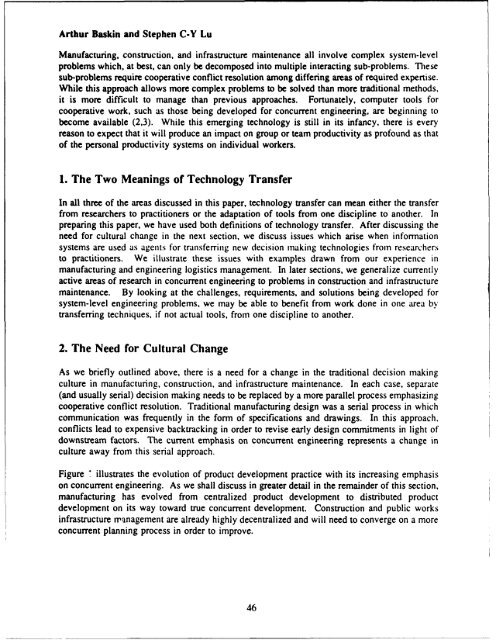Challenges and Opportunities for Innovation in the Public Works ...
Challenges and Opportunities for Innovation in the Public Works ...
Challenges and Opportunities for Innovation in the Public Works ...
You also want an ePaper? Increase the reach of your titles
YUMPU automatically turns print PDFs into web optimized ePapers that Google loves.
Arthur Bask<strong>in</strong> <strong>and</strong> Stephen C-Y Lu<br />
Manufactur<strong>in</strong>g, construction, <strong>and</strong> <strong>in</strong>frastructure ma<strong>in</strong>tenance all <strong>in</strong>volve complex system-level<br />
problems which, at best, can only be decomposed <strong>in</strong>to multiple <strong>in</strong>teract<strong>in</strong>g sub-problems. These<br />
sub-problems require cooperative conflict resolution among differ<strong>in</strong>g areas of required expertise.<br />
While this approach allows more complex problems to be solved than more traditional methods,<br />
it is more difficult to manage than previous approaches. Fortunately, computer tools <strong>for</strong><br />
cooperative work, such as those be<strong>in</strong>g developed <strong>for</strong> concurrent eng<strong>in</strong>eer<strong>in</strong>g, are beg<strong>in</strong>n<strong>in</strong>g to<br />
become available (2,3). While this emerg<strong>in</strong>g technology is still <strong>in</strong> its <strong>in</strong>fancy, <strong>the</strong>re is every<br />
reason to expect that it will produce an impact on group or team productivity as profound as that<br />
of <strong>the</strong> personal productivity systems on <strong>in</strong>dividual workers.<br />
1. The Two Mean<strong>in</strong>gs of Technology Transfer<br />
In all three of <strong>the</strong> areas discussed <strong>in</strong> this paper, technology transfer can mean ei<strong>the</strong>r <strong>the</strong> transfer<br />
from researchers to practitioners or <strong>the</strong> adaptation of tools from one discipl<strong>in</strong>e to ano<strong>the</strong>r. In<br />
prepar<strong>in</strong>g this paper, we have used both def<strong>in</strong>itions of technology transfer. After discuss<strong>in</strong>g <strong>the</strong><br />
need <strong>for</strong> cultural change <strong>in</strong> <strong>the</strong> next section, we discuss issues which arise when <strong>in</strong><strong>for</strong>mation<br />
systems are used as agents <strong>for</strong> transferr<strong>in</strong>g new decision mak<strong>in</strong>g technologies from researchers<br />
to practitioners. We illustrate <strong>the</strong>se issues with examples drawn from our experience <strong>in</strong><br />
manufactur<strong>in</strong>g <strong>and</strong> eng<strong>in</strong>eer<strong>in</strong>g logistics management. In later sections, we generalize currently<br />
active areas of research <strong>in</strong> concurrent eng<strong>in</strong>eer<strong>in</strong>g to problems <strong>in</strong> construction <strong>and</strong> <strong>in</strong>frastructure<br />
ma<strong>in</strong>tenance. By look<strong>in</strong>g at <strong>the</strong> challenges, requirements, <strong>and</strong> solutions be<strong>in</strong>g developed <strong>for</strong><br />
system-level eng<strong>in</strong>eer<strong>in</strong>g problems, we may be able to benefit from work done <strong>in</strong> one area by<br />
transferr<strong>in</strong>g techniques, if not actual tools, from one discipl<strong>in</strong>e to ano<strong>the</strong>r.<br />
2. The Need <strong>for</strong> Cultural Change<br />
As we briefly outl<strong>in</strong>ed above, <strong>the</strong>re is a need <strong>for</strong> a change <strong>in</strong> <strong>the</strong> traditional decision mak<strong>in</strong>g<br />
culture <strong>in</strong> manufactur<strong>in</strong>g, construction, <strong>and</strong> <strong>in</strong>frastructure ma<strong>in</strong>tenance. In each case, separate<br />
(<strong>and</strong> usually serial) decision mak<strong>in</strong>g needs to be replaced by a more parallel process emphasiz<strong>in</strong>g<br />
cooperative conflict resolution. Traditional manufactur<strong>in</strong>g design was a serial process <strong>in</strong> which<br />
communication was frequently <strong>in</strong> <strong>the</strong> <strong>for</strong>m of specifications <strong>and</strong> draw<strong>in</strong>gs. In this approach,<br />
conflicts lead to expensive backtrack<strong>in</strong>g <strong>in</strong> order to revise early design commitments <strong>in</strong> light of<br />
downstream factors. The current emphasis on concurrent eng<strong>in</strong>eer<strong>in</strong>g represents a change <strong>in</strong><br />
culture away from this serial approach.<br />
Figure ' illustrates <strong>the</strong> evolution of product development practice with its <strong>in</strong>creas<strong>in</strong>g emphasis<br />
on concurrent eng<strong>in</strong>eer<strong>in</strong>g. As we shall discuss <strong>in</strong> greater detail <strong>in</strong> <strong>the</strong> rema<strong>in</strong>der of this section,<br />
manufactur<strong>in</strong>g has evolved from centralized product development to distributed product<br />
development on its way toward true concurrent development. Construction <strong>and</strong> public works<br />
<strong>in</strong>frastructure mranagement are already highly decentralized <strong>and</strong> will need to converge on a more<br />
concurrent plann<strong>in</strong>g process <strong>in</strong> order to improve.<br />
46







